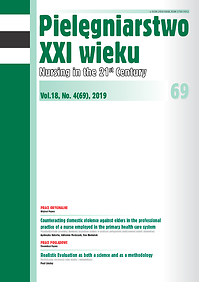Medical simulation – innovation in nursing education
DOI:
https://doi.org/10.2478/pielxxiw-2019-0034Keywords:
simulation, nursing, education, innovationAbstract
MEDICAL SIMULATION – INNOVATION IN NURSING EDUCATION
Aim. Analysis of the impact of educational simulation on the level of knowledge, skills and competences of nursing students.
Methods. The research used a non-systematic literature analysis method. Literature was classified for analysis, from which the contents on the impact of educational simulation on the education process of nursing students were selected. During the qualification of the magazines Google Scholar was used. Articles published in electronic databases were used: EBSCOhost, MEDLINE, ScienceDirect.
Conclusions. Education conducted using educational simulation in nursing not only increases the level of knowledge, skills and competences of students but also increases the quality of patient care and their security.
References
1. Kaya N, Turan N, Aydin GQ. A Concept Analysis of Innovation in Nursing. Procedia - Social and Behavioral Sciences. 2015: 195; 1674-1678.
2. Kaya N, Turan N, Aydin GQ. Innovation in Nursing: A Concept Analysis. J Comm Pub Health Nursing. 2016; 2:1-4.
3. Fulton CR, Clark C, Dickinson S. Clinical hours in nurse practitioner programs equals competence: Fact or misnomer? Nurse Educator. 2017; 42 (4): 195-198.
4. LeFlore JL, Thomas PE. Educational changes to support advanced practice nursing education. J Perinat Neonatal Nurs. 2016; 30 (3): 187-190.
5. Rutherford-Hemming T, Nye C, Coram C. Using simulation for clinical practice hours in nurse practitioner education in the United States: A systematic review Nurse Educ Today. 2016; 37: 128-135.
6. Sweeney N, Rollins MC, Gantt L, et al. Development and Reliability Testing of the Sweeney-Clark Simulation Evaluation Rubric. Clinical Simulation in Nursing. 2019.
7. Parry M, Fey MK. Simulation in Advanced Practice Nursing. Clinical Simulation in Nursing. 2019; 26:1-2.
8. Green M, Tariq R, Green P. Improving patient safety through simulation training in anesthesiology: Where are we now? Anesthesiology Research and Practice. 2016; 5:1-12.
9. Guido-Sanz F, Desiree A. Diaz, Anderson M, Gonzalez L, Houston A., Role Transition and Communication in Graduate Education: The Process. Clinical Simulation in Nursing.2019; 26: 11-17.
10. Lee J, Oh PJ. Effects of the use of high-fidelity human simulation in nursing education: A meta-analysis. J of Nurs Educ. 2015; 4 (9): 501-50.
11. Shin S, Park J-H, Kim J-H. Effectiveness of patient simulation in nursing education: Meta-analysis. Nurse Educ Today. 2015; 35, 1: 176-182.
12. Adamson K. A systematic review of the literature related to the NLN/Jeffries Simulation Framework. Nurs Educ Perspect. 2015; 36 (5): 281-291.
13. Sujatta S, Oberärztin L. First of all: Do not harm! Use of simulation for the training of regional anaesthesia techniques: Which skills can be trained without the patient as substitute for a mannequin. Best Pract Res Clin. Anaesthesiol. 2015; 29 (1): 69-80.
14. Starkweather A, Sargent L, Nye C, Albrecht T, Cloutier R, Foster A. Progressive assessment and competency evaluation framework for integrating simulation in nurse practitioner education. J Nurse Pract. 2017; 13 (7): 301-310.
15. Larue C, Pepin J, Allard E. Simulation in preparation or sub-stitution for clinical placement: A systematic review of the literature. J Nurse Educ and Pract. 2015: 5(9): 132-140.
16. Park H, Yu S. .Policy issues in simulation-based nursing education and technology development. Health Policy and Technology. 2018; 7, 3: 318-321.
17. Cant RP, Cooper. SJ. Use of simulation-based learning in undergraduate nurse education: An umbrella systematic review. Nurse Educ Today. 2017; 49: 63-71.
18. Tjoflåt I, Våga BB, Søreide E. Implementing simulation in a nursing education programme: a case report from Tanzania. Adv Simul (Lond). 2017; 3,2:17.
19. Anderson M, Campbell SH, Nye C, Diaz D, Boyd T. Simulation in Advanced Practice Education: Let’s Dialogue!! Clinical Simulation in Nursing. 2019; 26: 81-85.
Published
Issue
Section
License
Copyright (c) 2019 Authors

This work is licensed under a Creative Commons Attribution-NonCommercial-NoDerivatives 3.0 Unported License.




